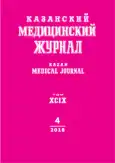Возрастные особенности активности свободнорадикального окисления в мембранах эритроцитов и плазме крови при постинфарктном кардиосклерозе у крыс
- Авторы: Реброва Т.Ю.1, Афанасьев С.А.1
-
Учреждения:
- Научно-исследовательский институт кардиологии, Томский национальный исследовательский медицинский центр Российской академии наук
- Выпуск: Том 99, № 4 (2018)
- Страницы: 629-634
- Тип: Экспериментальная медицина
- URL: https://bakhtiniada.ru/kazanmedj/article/view/9204
- DOI: https://doi.org/10.17816/KMJ2018-629
- ID: 9204
Цитировать
Полный текст
Аннотация
Цель. У крыс разного возраста в интактном состоянии и с развившимся постинфарктным кардиосклерозом определить присутствие продуктов перекисного окисления липидов и белков в мембранах эритроцитов и плазме крови.
Методы. У крыс в возрасте 4, 12, 24 мес моделировали постинфарктный кардиосклероз методом коронароокклюзии. В плазме крови и мембранах эритроцитов определяли продукты, реагирующие с тиобарбитуровой кислотой, и карбонильные производные аминокислотных остатков белков.
Результаты. В мембранах эритроцитов интактных животных 12 мес было отмечено уменьшение содержания продуктов, реагирующих с тиобарбитуровой кислотой, в сравнении с животными 4 мес, у животных 24 мес этот показатель значимо превышал значения у молодых особей. В плазме крови интактных животных в возрасте 12 и 24 мес выявлено повышенное содержание продуктов, реагирующих с тиобарбитуровой кислотой, относительно крыс 4 мес. В условиях постинфарктного кардиосклероза отмечено увеличение накопления этих продуктов в мембранах эритроцитов животных 4 и 24 мес. В плазме крови повышение этого показателя было отмечено только в группе 4-месячных животных с постинфарктным кардиосклерозом. В мембранах эритроцитов интактных крыс всех возрастных групп не получено различий по уровню карбонильных производных аминокислотных остатков белков, в плазме крови с возрастом он достоверно увеличивается. У животных 4 и 12 мес с постинфарктным кардиосклерозом интенсивное повышение содержания карбонильных производных аминокислотных остатков белков наиболее выражено в эритроцитарных мембранах. У животных 24 мес с постинфарктным кардиосклерозом этот показатель в мембранах и плазме крови стабилен.
Вывод. Интенсивность процессов перекисного окисления липидов клеточных мембран и крови имеет выраженные зависящие от возраста особенности, сохраняющиеся в условиях постинфарктного кардиосклероза; белки мембран эритроцитов интактных животных подвержены перекисной модификации в меньшей степени, чем белки плазмы крови; при формировании постинфарктного кардиосклероза у животных 4 и 12 мес карбонильные производные аминокислотных остатков белков интенсивнее накапливаются в мембранах эритроцитов по сравнению с плазмой крови.
Полный текст
Открыть статью на сайте журналаОб авторах
Татьяна Юрьевна Реброва
Научно-исследовательский институт кардиологии, Томский национальный исследовательский медицинский центр Российской академии наук
Автор, ответственный за переписку.
Email: rebrova@cardio-tomsk.ru
г. Томск, Россия
Сергей Александрович Афанасьев
Научно-исследовательский институт кардиологии, Томский национальный исследовательский медицинский центр Российской академии наук
Email: rebrova@cardio-tomsk.ru
г. Томск, Россия
Список литературы
- Анисимов В.Н. Молекулярные и физиологические механизмы старения. СПб.: Наука. 2003; 468 с.
- Дубинина Е.Е. Продукты метаболизма кислорода в функциональной активности клеток (жизнь и смерть, созидание и разрушение). Физиологические и клинико-биохимические аспекты. СПб.: Медицинская пресса. 2006; 400 с.
- Valko M., Leibfritz D., Moncol J. et al. Free radicals and antioxidants in normal physiological functions and human disease. Intern. J. Biochem. Cell Biol. 2007; 39: 44-84. doi: 10.1016/j.biocel.2006.07.001.
- Mirsa M.K., Sarwat M., Bhakuni P. et al. Oxidative stress and ischemic myocardial syndromes. Med. Sci. Monitor. 2009; 15: 209-219. PMID: 19789524.
- Реброва Т.Ю., Кондратьева Д.С., Афанасьев С.А. и др. Активность перекисного окисления липидов и функциональное состояние миокарда при ремоделировании сердца крыс после экспериментального инфаркта. Кардиология. 2007; 6: 41-45.
- Реброва Т.Ю., Афанасьев С.А., Медведева О.Д. и др. Возраст-зависимые особенности микровязкости мембран эритроцитов при экспериментальном кардиосклерозе. Успехи геронтол. 2012; 25 (4): 644-647.
- Levine R.L., Garlana D., Oliver C.N. et al. Determination of carbonyl content in oxidatively modified proteins. Methods in Enzymol. 1990; 186: 464-478. doi: 10.1016/0076-6879(90)86141-H.
- Оnishi S.T., Barr J.K. A simplified method of quantitating protein using the biuret and phenol reagents. Annal. Biochem. 1978; 86 (1): 193-200. doi: 10.1016/0003-2697(78)90334-2.
- Дубинина Е.Е., Пустыгина А.В. Cвободнорадикальные процессы при старении, нейродегенеративных заболеваниях и других патологических состояниях. Биомед. химия. 2007; 53: 351-372.
Дополнительные файлы






